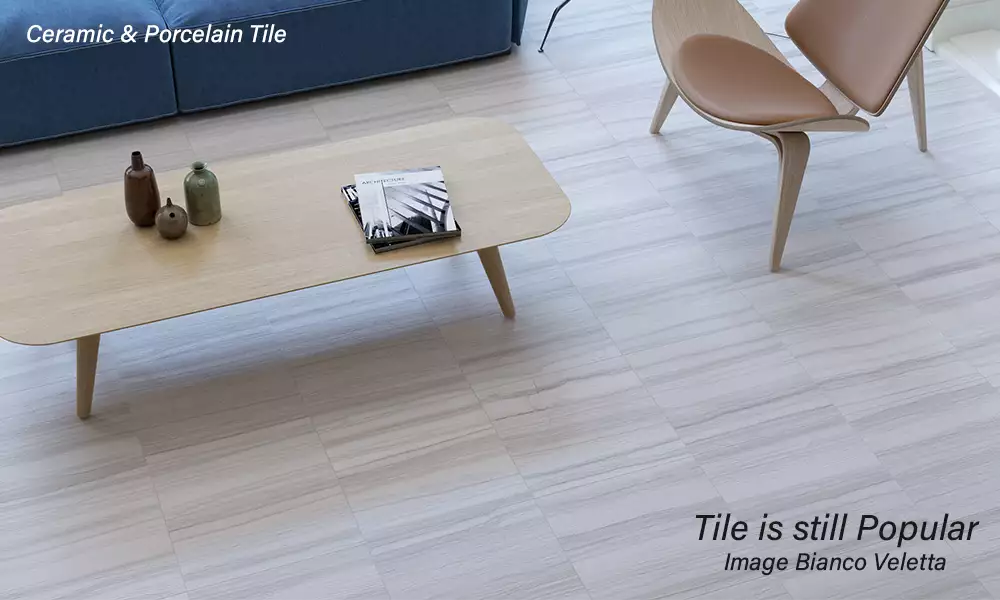
Yes, but in the Past couple of years, Home Owners and Renovators are now choosing easy to Install LVT or other Waterproof Flooring over Tile, are they making the right Choice? When considering New Flooring for your Home or Project remember. Tile is very Durable against Heavy Foot Traffic, Sliding or Castor mounted Chairs, Dirt and Sand.
I have heard from Several that choose LVP over Tile and were very Disappointed because the Wear Layer is not the Same. Chairs sliding Back & Forth or Stools mounted on Casters Rolling across the Floor will Go Through the Wear Layer Quickly. A Warranty Claim I was a Part of was the Wear Layer in a Teenagers Bedroom where the Chair mounted on "Soft Castors" Destroyed the Wear Layer within Months. The Warranty did not Cover the Damage.
I wouldn't not try to talk anyone out of their Decision for LVP or any other Waterproof Flooring , they have their place in the Industry. Just Consider Wear over Ease of Installation & Cost. It is Very Difficult to Scratch or Stain Tile, the Grout can Stain but that can be easily fixed. Ceramic and Porcelain Tile Laid down with a Small Grout Line will withstand way more Abuse from Chairs and Teenagers.
Difference between Ceramic and Porcelain
Ceramic and Porcelain Differ in the Raw Materials and Temperatures of the Kiln. Porcelain is more dense resulting in less water Absorption best for Wet Areas. Porcelain is Harder and more Brittle and can be a little Difficult to work with. Porcelain can be more expensive than Ceramic.
Interceramic Durabody® Ceramic Tile is Fired at the same Temperature and Glazed just like Porcelain Tile. It looks like and Performs the same as Porcelain. In most cases it costs less than Porcelain.
Finished edges can be Rectified or non-Rectified. Rectification is generally called “squaring”, this is the process where the tiles’ edges are cut or ground to a uniform work size with very minor variation for the ease of installation.
Definition of Terms or Descriptions
Polished Tiles are just that, using different sized Abrasives or Compounds to Obtain a Polished Grade.
Glossy/ Glazed is an Applied Glaze Material prior to the Kiln.
Satin has fewer Polish wheel Steps, a Surface less Polished.
Non Slip finish adds a fine Grit Sand is added to the Glaze
Unglazed Porcelain Floor Tile Can Provide a slip Resistant Surface.
Full Bodied Porcelain Tile are the Same Color Throughout, Could be Yellow to Red or White if the Tile is Chipped you may not need to replace the Tile.
Rectified is the Finished Edge, may be called “squaring”, the Cutting or Grinding Tile to a uniform work size with very or minor variation for the ease of installation.
Grout Lines Common Today are 1/8" to 3/16" Some Tiles and Manufactures require a 3/16" Grout Line, if a 1/8" Is what you want, be sure to ask if that is Acceptable.
Hardness, Resistance to Wear
Rating Tile for its ability to wear, (Resist Scratching) is what Determines where to use or not use Tile depending on Traffic. Wear Ability Ratings are Established by the Porcelain Enamel Institute (PEI). Tile PEI Rates are 1 - 5 or I, II, III, IV, V see the Chart Below. Most Tile used for Home Flooring is PEI III or IV.
Tile Hardness & Usage
- 0 is not to used on Floors
- I or 1 Light Residential Traffic
- II or 2 Medium Residential Traffic
- III or 3 Medium Residential & Light Commercial Traffic
- IV or 4 Normal Commercial Traffic
- V or 5 Heavy commercial Traffic
Moisture Absorption
If your Installation is Strictly Inside your Home then Non-Vitreous Tile (low Density) will absorb between 7% to 20% Moisture or Semi-Vitreous Tile (Medium Density) will absorb between 3% to 7% Moisture. Both Suggest Interior use only.
If your Installation is Outside You must Consider Moisture Absorption and or Freezing Temperatures. In this Case Porcelain may be a better choice. High Density Tile will absorbs .5% to 3% Moisture, Impervious Tile absorbs even less Moisture .5% or less. Both would be a Good Choice Outside in Damp and Freeze Areas.
Coefficient of Friction "Slipperiness"
DCOF or Dynamic Coefficient of Friction. A measurement that determines how much Friction there is on Wet Level Floors when walked upon. The Testing to determine a Rating is not Standard throughout the Industry. Each Manufacture will use their Own Values for the Test. A DCOF Rating of 0.42 is considered Standard for Tile that can be used in a Wet, Level Area. I suggest Appling Common Sense for any Tile you want Install, always Consider the Possibility of being Barefoot with Water on the Floor.
Breaking Point
Ceramic Breaking Strength measured by ASTM Testing. This Testing Method uses a Weighted Scale to obtain the Breaking point of 10 Tiles to get an Average Weight before Breaking. The Calculated Value is in Pounds Force, the amount of Force it takes to Break the Tile. Standards of 250 pounds for Floor Tile and 125 pounds for Wall Tile.
Note: The test is not a measurement for the Limit of Weight of Foot Traffic or what the Tile can Support but more of a Proof between Porcelain and Ceramic Tile.
Typical Ceramic tile is 350 - 475 lbf. Typical Porcelain Tile is 425 - 650 lbf.
Some Manufactures have Higher Ratings due to their Kiln Temperatures. Interceramic claims 550- 600 lbf for Ceramic and 475 - 750 for Porcelain.
The Performance of Interceramic Ceramic Tile is Equal to most Porcelain Tiles.
Voting System

“A long life may not be good enough, but a good life is long enough”
Benjamin Franklin
© Copyright 2023 YPRemodel.com. All rights Reserved. This material may not be Published, Broadcast, Rewritten or Redistributed without written Permission.
